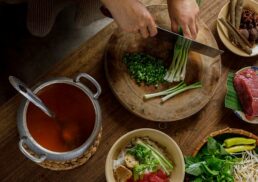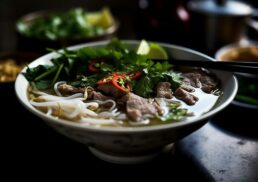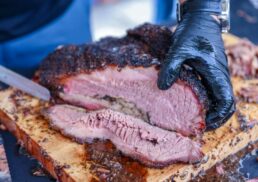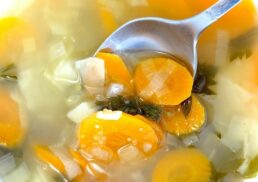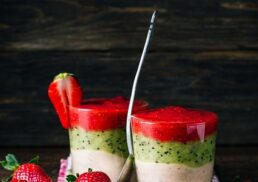Ever wondered about the variety of coffee kinds drink available? Whether you’re an espresso lover or prefer a chilled iced coffee, our list of 30 must-try coffee drinks this year will help you explore new flavors and find your next favorite brew.
Table of Contents
Key Takeaways
Understanding the differences between Arabica and Robusta beans can greatly enhance your coffee experience, with Arabica offering smooth, complex flavors and Robusta providing a strong, caffeine-packed punch.
Popular hot coffee drinks like lattes, cappuccinos, and macchiatos all begin with espresso, each offering a unique combination of espresso and milk to cater to different tastes.
Experimenting with different brewing methods, such as French press, drip coffee makers, and single-serve machines, allows you to tailor your coffee’s flavor and strength to your preferences.
Exploring Coffee Beans

We begin our exploration at the source: the coffee beans themselves, before we dive into the wide array of coffee drinks. The world of coffee is built upon a foundation of diverse bean varieties, each contributing its unique characteristics to the final brew. Understanding these differences is key to appreciating the nuances in your cup and making informed choices about the coffee drinks you explore. From the ubiquitous Arabica and Robusta to the lesser-known Liberica and Excelsa, each bean type tells a story of origin, cultivation, and flavor potential.
In this exploration, we will uncover the transformation of these humble seeds into the beloved beverage that powers our everyday lives.
Arabica vs. Robusta
When it comes to the coffee world, two giants stand tall: Arabica and Robusta. Arabica, the darling of coffee connoisseurs, accounts for over 60% of global coffee production. These beans are the prima donnas of the coffee world – delicate, demanding, and oh-so-rewarding when treated right. Grown at high altitudes with steady rainfall and ample shade, Arabica beans are highly susceptible to disease, requiring careful farming practices. The result? A coffee with a smooth, complex flavor profile that often features fruity, floral, and creamy nuances. When used for espresso, Arabica beans exhibit mild aromas and flavors that dance on your palate.
Conversely, we have Robusta, the bold, brash cousin of Arabica. While it may not have the same refined reputation, Robusta brings its own strengths to the table. These beans are the workhorses of the coffee world, thriving in a variety of climates and altitudes. Perhaps most notably, Robusta packs a serious caffeine punch, containing almost double the amount found in Arabica beans. This higher caffeine content contributes to Robusta’s signature strong, often bitter taste. In espresso, Robusta beans provide more caffeine and earthy notes, adding depth and complexity to blends.
Although Arabica is the star of specialty coffee shops, Robusta is essential in numerous popular coffee drinks, especially those that benefit from its robust flavor and creamy crema.
Lesser-Known Beans
While Arabica and Robusta dominate the coffee landscape, there’s a world of flavor waiting to be discovered in lesser-known bean varieties. Two such hidden gems are Liberica and Excelsa beans. Liberica beans, with their larger, often asymmetrical shape, offer a unique flavor profile that sets them apart from their more famous cousins. These beans tantalize the senses with floral and fruity notes, complemented by a distinctive smoky taste. Liberica’s claim to fame extends beyond its flavor – these beans played a crucial role in saving global coffee production after a devastating blight in 1890, offering a resilient alternative when other varieties faltered.
Excelsa beans, primarily grown in Southeast Asia, account for about 7% of global coffee circulation. These intriguing beans offer a complex flavor profile, blending tart and fruity notes with dark, roasty undertones. When added to blends, Excelsa beans bring an extra dimension of flavor, enhancing the overall complexity of the coffee. By exploring these lesser-known varieties, coffee lovers can expand their palates and gain a deeper appreciation for the diverse world of coffee beans.
Choosing Your Bean
Choosing the right coffee bean is a personal journey that can greatly enrich your coffee experience. As you delve into the world of coffee drinks, knowing your bean preferences becomes necessary. Your choice should be guided by two primary factors: personal taste preferences and desired caffeine levels. If you favor a smooth, nuanced flavor with subtle acidity, Arabica beans might be your go-to choice. On the other hand, if you crave a bold, strong cup with a higher caffeine kick, Robusta beans could be more your speed. Don’t be afraid to experiment with different bean types and blends – you might discover that a mix of Arabica and Robusta gives you the perfect balance of flavor and energy boost.
For the adventurous coffee drinkers, trying Liberica or Excelsa beans can open up new flavor dimensions you never knew existed in your cup. Remember, the world of coffee is vast and varied – your perfect bean is out there, waiting to be brewed!
Learn more How to Choose the Best Coffee Beans: A Beginner’s Guide.
Popular Hot Coffee Drinks

Having explored the foundations of coffee, namely the beans, we will now plunge into the intriguing world of hot coffee drinks. This category forms the backbone of coffee culture worldwide, offering a diverse array of flavors, textures, and experiences. From the pure, unadulterated essence of espresso to the creamy indulgence of a latte, hot coffee drinks cater to every palate and preference.
In this section, we will delve into the nuances of espresso-based beverages, reacquaint ourselves with timeless classic favorites, and unearth specialty concoctions that push the boundaries of what coffee can be. Whether you’re a traditionalist who swears by a simple Americano or an adventurous soul eager to try the latest coffee trend, this exploration of popular hot coffee drinks promises to deepen your appreciation for the art and science of coffee-making.
Espresso-Based Drinks
At the core of numerous cherished coffee drinks is the potent espresso – a concentrated shot of coffee that delivers a powerful burst of flavor and caffeine. To create this liquid gold, hot water is forced through finely-ground coffee beans under high pressure, resulting in a small but potent serving topped with a layer of crema. This process extracts the full spectrum of coffee’s flavors, creating a base that’s both versatile and complex. It’s no wonder that espresso serves as the foundation for a wide array of popular coffee drinks.
We commence our espresso exploration with the ristretto, the “restricted” shot. This variation uses less hot water than a traditional espresso, resulting in a sweeter and more intense flavor profile. The ristretto’s concentrated nature makes it a favorite among those who appreciate a bold coffee experience. Despite its smaller volume, the ristretto packs a flavorful punch, often described as having brighter and more complex notes compared to regular espresso shots. Interestingly, due to its shorter extraction time, a ristretto shot actually contains less caffeine than a standard espresso.
Conversely, we have the lungo, which is Italian for “long”. This variation uses twice the amount of water as a regular espresso, resulting in a longer extraction process. The result is a coffee that’s less strong but more bitter than its espresso counterpart. The lungo offers a unique flavor profile that some coffee lovers prefer, appreciating its smoky notes and slightly higher caffeine content. For those who enjoy the essence of espresso but find it too intense, the lungo provides a perfect middle ground.
Lastly, we should remember the doppio – a double shot of espresso that provides a more robust flavor profile. When expertly prepared, a doppio can showcase notes of caramelized sugar, chocolate, and spice, providing a complex and satisfying coffee experience. Whether you prefer your espresso short and sweet, long and bold, or doubled up, these variations demonstrate the versatility and depth of espresso-based drinks.
Classic Favorites
Venturing beyond pure espresso, we now discover classic coffee favorites that have withstood the test of time. These beloved drinks combine espresso with various amounts of milk and foam, creating a range of textures and flavors that cater to different preferences. We begin with the latte – a harmonious blend of espresso and steamed milk, crowned with a thin layer of foam. The latte’s popularity stems from its smooth, creamy texture and mild coffee flavor, making it accessible to a wide range of coffee drinkers. The key to a perfect latte lies in the milk – properly steamed milk requires skillful manipulation of temperature and pressure to achieve tiny bubbles that give it smoothness and sweetness. This versatile drink can be enjoyed hot or cold, with iced lattes being a popular choice in warmer climates or seasons.
Next on our journey through classic favorites is the cappuccino – a drink that perfectly balances espresso, steamed milk, and milk foam in equal parts. Originating in Italy during the 20th century, the cappuccino has become a global coffee icon. What sets the cappuccino apart is its luxurious layer of frothed milk foam, which gives the drink its characteristic light and airy texture. Often, a sprinkle of cocoa powder or cinnamon on top adds an extra layer of flavor and aroma. The cappuccino’s balanced composition makes it a favorite among those who appreciate a stronger coffee flavor than a latte but still enjoy the creaminess of milk.
Completing our trio of classics is the macchiato, a drink that forms a bridge between pure espresso and milk-based beverages. The traditional macchiato is a simple yet elegant creation: a shot of espresso “stained” or “marked” with a small amount of milk foam. This minimalist approach allows the espresso’s flavors to shine through while the touch of milk foam softens its intensity. For those who find espresso too strong but still want to taste its full flavor profile, the macchiato offers the perfect compromise.
Lastly, we shouldn’t overlook the flat white, a relatively new addition to the global coffee scene, yet rapidly gaining popularity. Originating from Australia or New Zealand (the debate continues), the flat white consists of espresso topped with steamed milk microfoam. The flat white’s unique preparation results in a velvety texture and a strong coffee flavor, setting it apart from lattes and cappuccinos. These classic favorites demonstrate how the simple combination of espresso and milk can create a diverse range of beloved coffee drinks.
Specialty Hot Coffees
As we delve deeper into the world of hot coffee drinks, we come across a range of specialty coffees that push the boundaries of traditional recipes. These unique concoctions often incorporate additional ingredients or special preparation methods to create distinctive flavor profiles. One such example is the Americano, a drink that combines the strength of espresso with the volume of drip coffee. Created by adding hot water to a shot of espresso, the Americano offers a strong flavor with less bitterness compared to regular black coffee. The preparation method is crucial here – in a long black, the espresso is added to hot water, while in an Americano, it’s the reverse, resulting in subtle differences in taste and crema preservation.
The cortado is another specialty hot coffee that warrants attention. This Spanish coffee beverage strikes a perfect balance between espresso and warm milk. The addition of steamed milk reduces the acidity often associated with espressos, creating a creamy consistency without overpowering the espresso flavor.
For those seeking a unique twist on their coffee routine, there’s beaten coffee, also known as cafe style hot coffee. This intriguing drink is made by vigorously beating instant coffee granules with sugar and hot water until a frothy mixture forms, then adding hot, frothed milk. The result is a visually striking and texturally interesting coffee experience.
Lastly, we can’t overlook the indulgent mocha coffee, a divine blend of:
espresso
steamed milk
chocolate powder or syrup
whipped cream
This dessert-like Turkish coffee drink satisfies both coffee cravings and sweet tooths, making it a popular choice for those who enjoy a touch of indulgence with their caffeine fix.
Refreshing Cold Coffee Drinks

Transitioning from the comforting warmth of hot coffee drinks, we enter the invigorating world of cold coffee drink options. These chilled concoctions have surged in popularity, offering a perfect way to enjoy coffee’s complex flavors while cooling down on a warm day. Cold coffee drinks aren’t just for summer anymore – they’ve become year-round favorites for many coffee enthusiasts.
In this section, we will examine a variety of cold coffee options, from straightforward iced coffees to more complex cold brew creations and decadent blended drinks. Each of these beverages offers a unique way to experience coffee, often highlighting different aspects of the bean’s flavor profile compared to their hot counterparts. Whether you’re looking for a crisp and refreshing pick-me-up or a creamy, dessert-like treat, the world of cold coffee drinks has something to satisfy every palate.
Iced Coffee Varieties
We begin our cold coffee journey with the simplest and most popular option: iced coffee. This refreshing beverage can be prepared in various ways, each offering a slightly different flavor profile. The simplest method involves pouring hot-brewed coffee over ice, resulting in a quick and easy chilled drink. However, this method can sometimes lead to a diluted flavor as the ice melts. To combat this, many coffee shops and home brewers opt for the cold brew method, which we’ll explore in more detail later.
Another popular iced coffee variety is the iced latte. This creamy delight is made by combining espresso with cold milk and pouring the mixture over ice. The result is a smooth, refreshing drink that maintains the rich flavor of espresso while offering the creamy texture of milk. Iced lattes are incredibly versatile and can be customized with various flavored syrups to create unique taste combinations.
For those who prefer a stronger coffee flavor, iced Americanos offer a great alternative. Made by adding cold water to espresso and serving over ice, this drink provides a bold coffee taste without the added calories of milk.
Lastly, for cappuccino lovers, the iced cappuccino provides a chilled version of the classic drink, typically served with little to no foam due to the cold preparation method. These iced coffee varieties demonstrate how traditional hot coffee drinks can be transformed into refreshing cold beverages, each with its own unique characteristics and appeal.
Cold Brew Creations
Cold brew coffee has transformed the world of chilled coffee beverages, providing a smooth, less acidic alternative to traditional iced coffee. Unlike its hot-brewed counterpart, cold brew is prepared by steeping coffee grounds in cold water for an extended period, typically 6 to 36 hours. This slow extraction process results in a coffee concentrate that’s naturally sweet and less bitter, with a silky mouthfeel that many coffee lovers adore. One of the key advantages of cold brew is its ability to maintain its flavor profile better than hot coffee that’s been cooled down, as it avoids the flavor loss associated with rapid cooling.
A thrilling variation in the world of cold brew is nitro cold brew. This innovative drink takes regular cold brew coffee and infuses it with nitrogen gas, creating a beverage that’s reminiscent of a dark beer in appearance and texture. The nitrogen infusion creates a cascade of tiny bubbles, resulting in a creamy, velvety texture with a beautiful, frothy head. Beyond its visual appeal, nitro cold brew offers a unique drinking experience. The infusion of nitrogen removes oxygen from the coffee, which helps preserve its flavor and reduces perceived acidity. Many coffee enthusiasts prefer to enjoy nitro cold brew without any additives to fully appreciate its smooth texture and rich flavor profile.
Whether you opt for classic cold brew or its nitrogen-infused cousin, these cold coffee creations offer a refreshing and flavorful way to enjoy your daily caffeine fix.
Blended Iced Coffee Drinks
For those who desire a more luxurious cold coffee experience, blended iced coffee drinks present a delightful fusion of coffee, ice, and often, sweet additions. The most famous of these concoctions is undoubtedly the Frappuccino, a trademarked beverage by Starbucks that has become synonymous with blended coffee drinks. Among the various types of coffee drinks, Frappuccinos and similar beverages start with a base of coffee or crème, which is then blended with ice and various flavorings such as syrups, chocolate, or caramel. The result is a smooth, icy drink that’s more akin to a milkshake than traditional coffee. These drinks often come topped with whipped cream and drizzles of sauce, making them a treat for both the eyes and the taste buds.
While they may not be the choice for purist coffee lovers, blended iced coffee drinks have found a huge following among those who enjoy their coffee on the sweeter side. They offer a playful and customizable way to enjoy coffee, especially on hot summer days when a frozen treat is just what you need to cool down and perk up.
Unique Coffee Beverages

Continuing our journey through the world of coffee, we now venture into the sphere of unique and exotic coffee beverages. These drinks push the boundaries of traditional coffee preparation, often incorporating unexpected ingredients or drawing inspiration from diverse cultural traditions.
From dessert-inspired creations that blur the line between coffee and confection to alcohol-infused concoctions that add a spirited twist to your caffeine fix, this category of coffee drinks offers something for every adventurous palate. We’ll also explore regional specialties that showcase how different cultures around the world have put their own spin on coffee preparation.
These unique beverages not only expand our understanding of what coffee can be but also offer a window into the rich tapestry of global coffee culture. Whether you’re looking to satisfy a sweet tooth, enjoy a grown-up coffee experience, or travel the world through your taste buds, these unique coffee beverages promise to take your coffee appreciation to new heights.
Dessert-Inspired Coffees
For those with a penchant for sweets, dessert-inspired coffees provide the ideal blend of indulgence and caffeine. These creative concoctions often blur the line between beverage and dessert, satisfying cravings for both coffee and sweets in one delightful package. One classic example is the affogato, an Italian treat that combines the rich intensity of espresso with the creamy sweetness of ice cream or gelato. Typically served in a cappuccino cup, the hot espresso is poured over a scoop of cold ice cream, creating a delightful contrast of temperatures and textures. The result is a simple yet sophisticated dessert that can be enjoyed as both a sweet treat and a coffee drink.
Another popular dessert-inspired coffee is the mocha latte, which brings together the bold flavors of espresso with the indulgent sweetness of chocolate. This harmonious blend is then topped with steamed milk and a layer of foam, creating a drink that’s both comforting and luxurious.
For those who prefer their dessert-inspired coffees with a bit more simplicity, there’s the Espresso Con Panna. This elegant drink consists of a shot of espresso topped with a dollop of whipped cream, offering a perfect balance of rich coffee flavor and creamy sweetness. Espresso Con Panna can be enjoyed hot or cold, and creative baristas often enhance it with additional flavorings like cinnamon or nutmeg for an extra layer of complexity.
These dessert-inspired coffees, available at your favorite coffee shop, demonstrate how the bold, complex flavors of coffee can be transformed into indulgent treats that satisfy both coffee cravings and sweet tooths alike.
Alcohol-Infused Coffees
For those seeking a more mature twist on their coffee experience, alcohol-infused coffees provide an intriguing mix of caffeine and spirits. Perhaps the most famous of these is Irish Coffee, a warming combination of hot coffee, Irish whiskey, sugar, and a layer of lightly whipped cream on top. This classic hot coffee drink perfectly balances the bold flavors of coffee and whiskey with the sweetness of sugar and the richness of cream.
The Carajillo is a well-liked option, as it combines hot coffee with a touch of liquor, often rum, whiskey, brandy, or anisette. This traditional Spanish beverage is known for its flavorful combination of ingredients. This versatile drink can be enjoyed hot or cold, making it a favorite in both winter and summer months.
For those who prefer their coffee with an Italian flair, there’s the Caffè Corretto, which translates to “corrected coffee.” This drink consists of a shot of espresso “corrected” with a small amount of liquor, often grappa or anisette. These alcohol-infused coffees showcase how the addition of spirits can enhance and transform the coffee-drinking experience, creating complex and sophisticated beverages that are perfect for social occasions or as an after-dinner treat.
Regional Specialties
Exploring the world of unique coffee beverages, we can’t ignore the fascinating regional specialties that mirror local tastes and traditions. One such example is Vietnamese coffee, renowned for its use of robusta beans and distinctive preparation method. Vietnamese iced coffee, in particular, has gained international popularity for its rich, chocolatey flavor profile, achieved by combining strong coffee with sweetened condensed milk over ice. For those seeking an even more unique Vietnamese coffee experience, there’s Ca Phe Trung, also known as egg coffee. This intriguing beverage combines sweetened condensed milk with strong espresso and a creamy, custard-like topping made from whisked egg yolks.
Venturing to another part of the world, we find Cafe de Olla, a traditional Mexican coffee that’s as much about the preparation as it is about the flavor. This aromatic drink is brewed with cinnamon and piloncillo (unrefined cane sugar), resulting in a spiced coffee with a unique sweetness. Often prepared in earthenware pots, Cafe de Olla embodies the rich culinary traditions of Mexico, with many of its beans sourced from the Michoacan region.
These regional specialties offer coffee lovers a chance to explore how different cultures have adapted and enhanced coffee to suit local tastes, creating beverages that are not just drinks, but windows into diverse culinary traditions.
Coffee Roasts and Their Impact
As we delve further into the world of coffee, it’s essential to understand the significant role roasting plays in defining the flavor, aroma, and overall character of your cup. Coffee roasting is both an art and a science, transforming the raw, green coffee beans into the aromatic brown beans we know and love. The roasting process consists of three main phases: drying, browning, and developing or roasting. Each stage contributes to the final flavor profile of the coffee.
Roasting is typically classified into four main levels:
Light
Medium
Medium-dark
Dark
Each roast level brings out different qualities in the coffee beans, affecting everything from acidity and body to sweetness and bitterness. As we explore each roast level in the following sections, you’ll gain insights into how the roasting process shapes the coffee you enjoy every day, and perhaps discover new preferences along the way.
Light Roast
Light roast coffee represents the gentlest touch of the roaster’s art, preserving much of the bean’s original character. These beans are typically lighter in color and have a matte surface, as they haven’t been roasted long enough for oils to break through to the surface. The light roasting process is typically completed around the “first crack,” when the beans make a popping sound similar to popcorn. This minimal roasting results in a coffee that’s higher in acidity, with a bright, vibrant flavor profile. Light roasts often showcase the unique characteristics of their origin, allowing the natural flavors of the bean to shine through.
For Arabica beans, this can mean citrusy, lemony, or bergamot notes that dance on the palate. The texture of light roast coffee is generally less creamy than darker roasts, with a thinner body that allows these complex flavors to take center stage. While some coffee drinkers find light roasts too acidic or lacking in the traditional “coffee” flavor, others appreciate their nuanced taste profiles and the way they highlight the terroir of the coffee’s origin.
Medium Roast
Moving along the roasting spectrum, we arrive at medium roast coffee, often referred to as American or breakfast roast. This popular roast strikes a balance between preserving the bean’s original flavors and developing the rich, caramelized notes that come with longer roasting times. Medium roast beans are roasted until just after the first crack, but before the second crack begins, typically reaching temperatures between 410°F and 430°F. This level of roasting allows some oils to develop on the surface of the beans, contributing to a fuller body compared to light roasts.
The flavor profile of medium roast coffee includes:
Nutty notes
Earthy notes
Floral notes
Smooth and creamy finish
This versatility makes medium roast a favorite among coffee drinkers who appreciate a classic coffee taste without the extremes of very light or very dark roasts.
Dark Roast
At the far end of the roasting spectrum, we find dark roast coffee, known for its bold, rich flavors and lower acidity. Dark roast beans are easily recognizable by their dark brown, almost black color and shiny, oily surface. This oily sheen is the result of a longer roasting process, typically reaching temperatures between 460°F and 482°F. As the beans are roasted for a longer time, they lose more of their original flavors and take on characteristics from the roasting process itself. The result is a coffee with a strong, often bitter taste, featuring prominent notes of chocolate and smokiness.
While dark roasts may have less of the bean’s original flavor punch, they make up for it with a full body, creamy undertones, and a smooth finish. This roast level is particularly popular for espresso blends, as it cuts through milk well and provides a robust flavor in milk-based drinks. It’s worth noting that contrary to popular belief, dark roast coffee doesn’t necessarily contain more caffeine than lighter roasts – in fact, the roasting process can slightly reduce caffeine content.
Brewing Methods
Having explored the world of coffee beans and roasts, it’s now time to delve into the various methods of transforming those beans into the delicious beverage we all relish. The brewing method you choose can significantly impact the flavor, strength, and overall character of your coffee. From the simplicity of a French press to the precision of pour-over, each brewing technique offers a unique way to extract flavors from your coffee grounds.
Some popular brewing methods include:
French press
Pour-over
Espresso
Aeropress
Cold brew
Experiment with different brewing methods to find your favorite and enjoy the perfect cup of coffee every time.
In this section, we will examine some of the most popular brewing methods, including the French press, drip coffee makers, and single-serve machines. We’ll discuss the pros and cons of each method, helping you understand how they affect the final taste of your coffee.
Whether you’re a coffee novice looking to expand your brewing repertoire or a seasoned aficionado seeking to perfect your technique, this exploration of brewing methods will provide valuable insights to enhance your coffee experience.
French Press
The French press, with its simple yet effective design, has long been a favorite among coffee enthusiasts. This brewing method falls under the category of immersion brewing, where coffee grounds are fully immersed in water and then strained using a metal filter. The process is straightforward:
Add ground coffee beans to the French press.
Pour hot water over the grounds.
Let it steep for a few minutes.
Press the plunger down to separate the brewed coffee from the grounds.
What sets the French press apart is its ability to produce a full-bodied coffee with a rich, robust flavor. The metal filter allows more oils and fine particles to pass through compared to paper filters, resulting in a cup of coffee with a heavier mouthfeel and more intense flavor. This method is particularly well-suited for darker, richer roasts, as it can fully extract their complex flavors. However, it’s versatile enough to work well with any type of roast, allowing you to experiment and find your perfect brew.
The French press is also praised for its simplicity and eco-friendliness, as it doesn’t require disposable filters or electricity to operate.
Drip Coffee Makers
Drip coffee makers have been a staple in homes and offices for decades, beloved for their convenience and consistency. These machines typically use a glass carafe to collect the brewed coffee, although some models feature thermal carafes for better heat retention. The brewing process is straightforward: you scoop the desired amount of ground coffee into a filter, add water to the reservoir, and let the machine do the rest. Hot water is automatically dripped over the coffee grounds, extracting the flavors as it passes through and collecting in the carafe below. This method produces a clean, well-balanced cup of coffee, as the paper filters trap most of the oils and sediment.
While it may not offer the same level of control as manual brewing methods, drip coffee makers excel in convenience, especially for those who need to brew larger quantities of coffee. They’re also great for households with multiple coffee drinkers who may have different schedules, as the hot plate can keep the coffee warm for extended periods. However, it’s worth noting that leaving coffee on a hot plate for too long can lead to a bitter taste, so it’s best to enjoy it fresh or transfer it to a thermal carafe if you plan to drink it over several hours.
Single Serve Coffee Makers
In recent years, single serve coffee makers have surged in popularity, offering unparalleled convenience for those who want a quick, fresh cup of coffee without the fuss of brewing a whole pot. These machines are particularly beneficial for single-person households or offices where individual preferences vary widely.
The brewing process is incredibly simple: you insert a coffee pod or capsule, add water to the reservoir, and press a button. Within minutes, you have a freshly brewed cup of coffee tailored to your preferences. One of the key advantages of single serve coffee makers is their versatility – many models offer options for different cup sizes and even allow you to brew tea or hot chocolate.
Additionally, these machines are often more budget-friendly in the long run, as they eliminate the need for expensive coffee filters or pods. However, it’s worth considering the environmental impact of disposable pods. Many manufacturers now offer recyclable or compostable options, and some machines allow you to use reusable filters with your own ground coffee, providing a more eco-friendly alternative.
While single serve coffee makers may not offer the same depth of flavor as some other brewing methods, their convenience and consistency make them a popular choice for many coffee drinkers.
Enhancing Your Coffee Experience
As we near the conclusion of our coffee journey, it’s time to explore ways to enhance your coffee experience beyond the basics of beans, roasts, and brewing methods. The world of coffee offers endless opportunities for customization and experimentation, allowing you to tailor each cup to your exact preferences. In this section, we will delve into various ways to enhance your coffee, from flavor additions that can elevate a simple brew into a gourmet treat, to the art of choosing the perfect milk or cream to complement your coffee’s natural flavors.
We’ll also explore food pairings that can elevate your coffee-drinking experience to new heights. Whether you’re looking to perfect your daily cup or impress guests with your coffee prowess, these tips and tricks will help you make the most of every sip. Remember, enhancing your coffee is all about personal taste – don’t be afraid to experiment and find what works best for you!
Flavor Additions
One of the most enjoyable ways to elevate your coffee experience is through flavor additions. These can range from simple sweeteners to complex syrups and spices, each offering a unique twist on your favorite brew.
Flavored syrups, such as vanilla, caramel, or hazelnut, are popular choices that can elevate the sweetness and complexity of your coffee. These syrups are particularly versatile, working well in both hot and iced coffee drinks.
For those who prefer a more subtle approach, consider infusing your coffee with spices like cinnamon, nutmeg, or cardamom. These aromatic additions can enhance the natural flavors of your coffee while adding an extra layer of warmth and complexity.
If you’re looking to balance the bitterness of your coffee without adding sweetness, a pinch of salt can work wonders. This might sound counterintuitive, but a small amount of salt can actually help to round out the flavors and reduce perceived bitterness.
For a creamy indulgence, consider adding a touch of cream or a dollop of whipped cream to your coffee. This not only adds richness but can also help to balance strong or acidic coffees.
Remember, the key to successful flavor additions is moderation – start with small amounts and adjust to your taste preferences.
Milk and Cream Options
The choice of milk or cream can significantly influence the flavor and texture of your coffee, thus it is an essential consideration for coffee enthusiasts. Traditional dairy options like whole milk, skim milk, and heavy cream are popular choices, each offering a different level of richness and creaminess.
Different types of milk can enhance your coffee in different ways:
Whole milk, with its higher fat content, provides a creamy texture and helps to balance the acidity of coffee.
Skim milk allows more of the coffee’s natural flavors to shine through while still providing a touch of sweetness.
Heavy cream offers the ultimate indulgence, creating a luxuriously rich and velvety coffee experience.
For those who prefer non-dairy alternatives, there’s a wide array of plant-based milk options available. Almond milk, for example, offers a creamy texture with subtle nutty undertones that pair particularly well with dark roast coffees. Coconut milk brings a unique tropical flair to your cup, adding a subtle sweetness that complements milder coffee flavors.
Other popular options include soy milk, oat milk, and cashew milk, each offering its own unique flavor profile and texture. When choosing a plant-based milk, consider how its flavor will interact with your coffee – some may enhance certain notes in your brew, while others might mask them. It’s also worth noting that some plant-based milks are specifically formulated for use in coffee, designed to froth and blend better than their standard counterparts.
Whichever milk or cream option you choose, remember that it’s not just about adding creaminess – it’s about finding the perfect complement to your coffee’s natural flavors.
Perfect Pairings
The art of pairing food with coffee can transform your coffee experience from a simple beverage to a culinary delight. As wine enthusiasts meticulously choose foods to complement their preferred vintages, coffee lovers can enrich their experience by selecting the right accompaniments.
Pastries, such as croissants and muffins, are classic choices that complement the rich flavors of coffee beautifully. The buttery, flaky texture of a croissant, for instance, can provide a delightful contrast to the bold flavors of a dark roast coffee.
For those who prefer a lighter touch, fresh fruits like berries or citrus can offer a refreshing counterpoint to coffee’s intensity. The natural sweetness and acidity of fruits can help to highlight different notes in your coffee, creating a more complex and enjoyable taste experience.
Perhaps one of the most beloved pairings is coffee and chocolate. Dark chocolate, in particular, pairs exceptionally well with coffee, its rich cocoa flavors harmonizing with the roasted notes in the brew. This combination not only tastes delicious but can also enhance the perceived sweetness of your coffee without adding sugar.
Whether you’re enjoying a quick morning cup or savoring a leisurely after-dinner coffee, considering your food pairings can transform your coffee routine into a more mindful and enjoyable ritual.
Summary
As we conclude our journey through the world of “30 Coffee Kinds Drink You Need to Try This Year,” it’s clear that coffee is far more than just a morning pick-me-up – it’s a diverse and fascinating universe of flavors, cultures, and experiences. We’ve explored the foundations of coffee, from the different types of beans to the impact of roasting levels. We’ve delved into a wide array of hot and cold coffee drinks, from classic espresso-based beverages to unique regional specialties. We’ve examined various brewing methods, each offering its own unique approach to extracting the perfect cup. And we’ve discovered ways to enhance our coffee experience through flavor additions, milk options, and food pairings. Throughout this journey, one thing has become abundantly clear: there’s a coffee drink out there for everyone, whether you prefer your coffee strong and black, sweet and creamy, or somewhere in between. The world of coffee is constantly evolving, with new trends and innovations emerging all the time. So, as you go forward, we encourage you to keep exploring, experimenting, and discovering new ways to enjoy this beloved beverage. Whether you’re trying a new brewing method, sampling beans from a different region, or creating your own unique coffee concoction, remember that every cup is an opportunity for discovery. Here’s to your continued adventures in the wonderful world of coffee!
Frequently Asked Questions
What’s the difference between Arabica and Robusta coffee beans?
Arabica coffee beans have a smooth, complex flavor with fruity and floral notes and are grown at higher altitudes, while Robusta beans have a stronger, often bitter taste and contain more caffeine. Arabica is typically higher quality and used in specialty coffees, while Robusta is commonly used in espresso blends and instant coffee.
How does the roasting process affect coffee flavor?
The roasting process has a significant impact on coffee flavor. Light roasts maintain the bean’s original flavors, resulting in a more acidic and fruity taste, while dark roasts bring out oils and caramelized sugars, resulting in a bold, rich flavor with lower acidity and more bitterness.
What’s the difference between cold brew and iced coffee?
The key difference between cold brew and iced coffee lies in their preparation method. Iced coffee is made by cooling down hot brewed coffee, while cold brew involves steeping coffee grounds in cold water for an extended period, resulting in a smoother, less acidic taste with higher caffeine content.
Can you explain the difference between a latte, cappuccino, and flat white?
A latte has more steamed milk and a thin layer of foam, while a cappuccino has equal parts espresso, steamed milk, and milk foam. In comparison, a flat white has a higher ratio of coffee to milk and is topped with finely textured milk, resulting in a stronger coffee flavor and velvety texture.
What’s the best way to store coffee beans to maintain freshness?
To maintain the freshness of your coffee beans, store them in an airtight container in a cool, dark place. Avoid the refrigerator or freezer, as moisture can degrade the beans’ quality. Buy whole beans, grind them just before brewing, and use them within two weeks of roasting for the best flavor.
